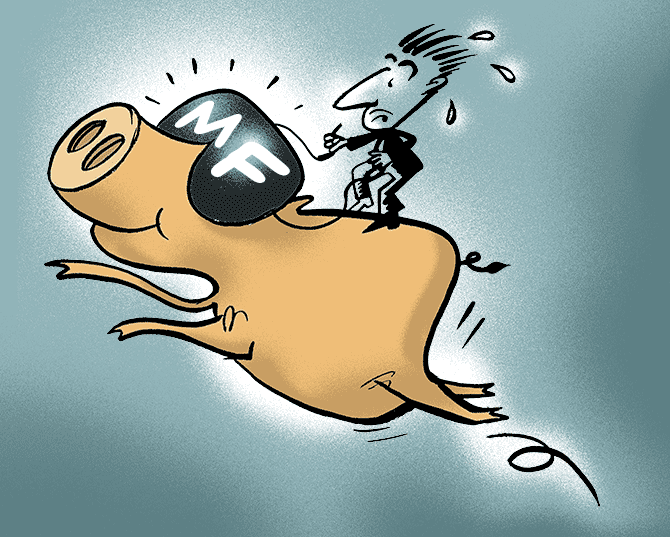 | « Back to article | Print this article |
Fund houses have conducted investor camps and awareness programmes in more than 400 cities.
Also, the popular 'Mutual fund sahi hai' campaign has helped bring in a lot of new investors into the MF fold from under-penetrated regions.
Ashley Coutinho reports.
 >
>
At the end of April, assets under management (AUM) from the B30 locations stood at Rs 4.02 trillion, while the top 30 (T30) centres accounted for Rs 19.2 trillion.
In February, the Securities and Exchange Board of India tweaked the extra incentive structure for generating assets from the beyond 15 (B15) cities.
From April 1, the market regulator has said, fund houses will be allowed to pay an extra commission of 30 basis points for incremental flows from the B30 cities, as distinct from the B15 cities earlier.
Accordingly, the terms and definitions of '15 cities', 'T15' and 'B15' have been substituted with '30 cities', 'T30' (top 30) and 'B30', respectively.
Helped by the extra incentive and focus by the industry, AUM from the B15 cities have grown more than 35 per cent a year in the past two years.
For instance, the B15 AUM increased 41.7 per cent to Rs 3.09 trillion as on March 31, 2017 compared to the year-ago period.
It further increased by 38 per cent year-on-year to Rs 4.26 trillion at the end of March 2018.
In comparison, the AUM from T15 (top 15) cities grew 36 per cent and 19 per cent, respectively, during this period.
While the figures for April are not comparable given the change in definitions, industry experts believe that the momentum from smaller towns remains strong.
Going by the earlier definition, the share of the B15 cities in AUM stood at 18.77 per cent as of the end of March 2018, the highest in at least four years.
In comparison, the share of T15 has been consistently declining and stood at 81.23 per cent at the end of March 2018, down from 84.38 per cent at the end of March 2015.
Industry experts say the share of smaller centres in overall assets will only go up as fund houses and distributors tap into these territories to pocket a higher commission.
Already, fund houses have conducted investor camps and awareness programmes in more than 400 cities.
Also, the popular 'Mutual fund sahi hai' campaign has helped bring in a lot of new investors into the MF fold from under-penetrated regions.
The first phase of the campaign started last year with the idea of debunking myths surrounding MFs.
Besides, asset management companies have also increased their footprint in smaller locations.
All these factors, together with a sustained uptick in the market, have helped the cause of increasing the acceptability of mutual funds in these locations.
The Sensex surged about 11 per cent in financial year 2018, and has rallied more than 40 per cent during the four years of Prime Minister Narendra D Modi at the helm.
According to Amfi's recent data, the B30 locations showed an affinity towards equity assets, with 65 per cent of the MF assets from these locations being in equity schemes as of April 2018.
In contrast, just about 36 per cent of the T30 assets were in equity schemes.
The higher concentration of debt assets in T30 locations was due to a higher proportion of institutional participants from these locations, Amfi said.
About 27 per cent of the overall MF assets held by individual investors came from the B30 locations.
On the other hand, just about 7 per cent of institutional MF assets came from B30 locations, and the remaining 93 per cent was from the T30 locations.

Individual investors held Rs 12.07 trillion in mutual funds as of April 2018, an increase of 36 per cent over April 2017.
Direct investments amount to 15 per cent of individual assets -- 3 per cent from B30 and 12 per cent from T30.
Average investment corpus of a retail investor is Rs 79,000, while that of a corporate investor, Rs 22.8 million.
Average ticket size of an equity MF investor is Rs 155,146.
The number of investor accounts has increased to 72 million, of which 67 million belong to retail investors -- those investing less than Rs 500,000.
In December 2014, the investor account count stood at just 40 million.
Among states that top the AUM charts are Maharashtra, Delhi, Goa and Gujarat, the data shows.
Assets managed by the Indian mutual fund industry have grown from Rs 19.11 trillion in April 2017 to Rs 23.21 trillion in April 2018. This represents a 21.4 per cent growth in assets over April 2017.
Illustration: Dominic Xavier/Rediff.com